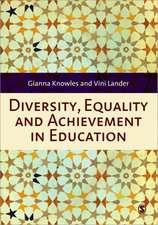Culturally Proficient Education: An Asset-Based Response to Conditions of Poverty
Autor Randall B. Lindsey, Michelle S. Karns, Keith T. Myatten Limba Engleză Paperback – 14 iun 2010
Preț: 247.52 lei
Nou
Puncte Express: 371
Preț estimativ în valută:
47.36€ • 49.45$ • 39.20£
47.36€ • 49.45$ • 39.20£
Carte tipărită la comandă
Livrare economică 04-18 aprilie
Preluare comenzi: 021 569.72.76
Specificații
ISBN-13: 9781412970860
ISBN-10: 1412970865
Pagini: 176
Dimensiuni: 178 x 254 x 15 mm
Greutate: 0.36 kg
Ediția:New.
Editura: SAGE Publications
Colecția Corwin
Locul publicării:Thousand Oaks, United States
ISBN-10: 1412970865
Pagini: 176
Dimensiuni: 178 x 254 x 15 mm
Greutate: 0.36 kg
Ediția:New.
Editura: SAGE Publications
Colecția Corwin
Locul publicării:Thousand Oaks, United States
Recenzii
"Students
in
poverty
circumstances
need
us
more
than
ever.
This
book
provides
tools,
resources,
and
thought-provoking
vignettes
to
illustrate
what
can
transform
our
educational
practice
to
meet
the
needs
of
all
kids.
After
reading
this
book,
I
am
astounded
by
how
we
have
compartmentalized
educational
programming
to
reduce
achievement
gaps
and
yet,
after
decades
of
research,
found
this
to
be
ineffective.
This
new
application
for
cultural
proficiency
is
a
testament
to
the
educator-student
relationship
based
on
respect,
understanding,
and
a
common
purpose,
no
matter
what
the
background
or
culture
of
the
student
happens
to
be.
We
can't
afford
for
more
students
to
disengage
from
education.
Thankfully,
the
authors
frame
that
for
us
in
a
way
that
builds
on
where
we
are
in
our
learning
and
moves
us
forward
toward
a
positive,
asset-building
environment
rather
than
a
destructive
deficit
mind-set."
"Before we can look at our students in a way that emphasizes what strengths and skills they bring to the classroom, we need to look at ourselves, our biases, and preconceptions. This book is an interactive model that uses the tools of cultural proficiency as a lens to look not only at our students, but also ourselves. This self-reflection enables us to be more effective for all our students."
"Before we can look at our students in a way that emphasizes what strengths and skills they bring to the classroom, we need to look at ourselves, our biases, and preconceptions. This book is an interactive model that uses the tools of cultural proficiency as a lens to look not only at our students, but also ourselves. This self-reflection enables us to be more effective for all our students."
Cuprins
Foreword
by
Dennis
Parker
Acknowledgments
About the Authors
Part I. Why Poverty and Cultural Proficiency?
Introduction
1. Asset-Based Approaches to Students From Low Income or Impoverished Communities
2. The Middle Class School in Communities of Poverty
3. The Cultural Proficiency Tools Build on Assets
Part II. Pro-social School Applications
4. Culturally Proficient Pedagogy
5. Culturally Proficient Leadership Support for Instruction
6. Policy Development to Ensure and Support Teaching and Learning
Part III. A Call to Action
7. A Call to Action: The Time Is Now
Appendix A: Cultural Proficiency Conceptual Framework
Appendix B: State Teachers’ Association Retreat Script
Appendix C: Taniko’s Poem
Appendix D: How to Use Cultural Proficiency Books
References
Index
Acknowledgments
About the Authors
Part I. Why Poverty and Cultural Proficiency?
Introduction
1. Asset-Based Approaches to Students From Low Income or Impoverished Communities
2. The Middle Class School in Communities of Poverty
3. The Cultural Proficiency Tools Build on Assets
Part II. Pro-social School Applications
4. Culturally Proficient Pedagogy
5. Culturally Proficient Leadership Support for Instruction
6. Policy Development to Ensure and Support Teaching and Learning
Part III. A Call to Action
7. A Call to Action: The Time Is Now
Appendix A: Cultural Proficiency Conceptual Framework
Appendix B: State Teachers’ Association Retreat Script
Appendix C: Taniko’s Poem
Appendix D: How to Use Cultural Proficiency Books
References
Index
Descriere
This
book
is
dedicated
to
providing
readers
with
the
knowledge
and
skills
to
maximize
the
educational
opportunities
for
children
raised
in
low
socio-economic
conditions.










